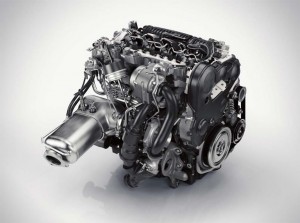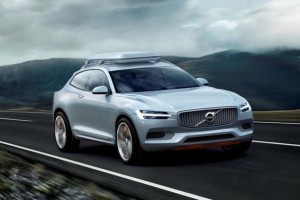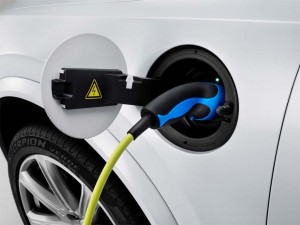With plans to completely redefine its line-up, top to bottom, Volvo is offering up new details on the three powertrain packages it will be offering in the next-generation XC90, the Swedish maker boasting that they will make it “the world’s most powerful and cleanest SUV.”
While that claim will be open to challenge, the new XC90 will, at one extreme, offer a dual supercharged and turbocharged 2.0-liter inline-four making a solid 400 horsepower, while at the other extreme it promises a combined fuel economy of 56 mpg from a new turbodiesel.
“There are no compromises when you drive an all-new XC90,” said Peter Mertens, Senior Vice President Research and Development of Volvo Car Group. “In the past you could either have power or low CO2 emissions. But with the all-new XC90 you can have both.”
Now owned by the Chinese automaker Geely, Volvo is struggling to reverse years of declining sales and financial hardships. The XC90 will serve as something of a poster child for the maker’s new strategy which will rely on two new modular platforms for its entire product range – while it shifts to an all-four-cylinder powertrain strategy.
(Volvo may soon begin importing cars from China. Click Herefor the story.)

Volvo is rapidly migrating to an all-four-cylinder strategy, both diesel, gas, and battery-electric.
Volvo has been dropping hints of what’s coming for quite a few months. That includes the distinctive Concept XC Coupe it revealed at the Detroit Auto Show last January, as well as some teaser images of the new SUV’s cabin forwarded to our inbox in April. Last month, Volvo followed up with details on its new infotainment system, and we anticipate getting more images of the next XC90’s exterior before the official autumn unveiling.
But the details its releasing now about the new powertrain line-up make for some compelling reading. Where Volvo followed the traditional, bigger-is-better strategy in years past, it is making a major transition going forward as it continues to roll out its recently launched Drive-E engine family. Volvo is far from the only maker looking to downsize its powertrains. As TheDetroitBureau.com is separately reporting, Lexus will offer its first turbocharged model on the new NX 200t crossover.
(For more on the new Lexus NX 200t, Click Here.)
But Lexus also will have a big V-8 powering its new 2015 RC-F coupe. By the end of the decade, Volvo will offer only I-4s, whether gas or diesel, naturally aspirated, turbo or supercharged, or even paired with hybrid or plug-in battery-electric modules.
At the top of the line will be the 2015 Volvo XC90’s new T8 model. Instead of an eight-banger, however, it will opt for a distinctive 2.0-liter four that uses both a turbo and a supercharger – as well as a plug-in hybrid assist system that includes an 80-hp electric motor. Add it in and the system will kick out a full 400-hp and 472 lb-ft of torque.

The Volvo Concept XC Coupe, which debuted in Detroit, blends new and old design elements. It's one of three concepts the maker debuted recently.
Along with the sleek new design, that should be enough in itself to grab the attention of those who still lump Volvo into the boxy-and-boring category. But it hasn’t forgotten its traditional roots, and the new XC90 T8 should also deliver about 25 miles of range per charge, according to Volvo, while producing a miniscule 60 grams of CO2 per kilometer.
(For more on the new XC90, Click Here.)
For those who put a premium on fuel economy or, in European terms, CO2 emissions, there will be several alternatives, including two new diesels. One, making a modest 190-hp and 295 lb-ft is expected to deliver an impressive 56 mpg in combined City/Highway driving. Also available will be a more peppy turbodiesel turning out 225-hp and 347 lb-ft.
Volvo has not said what its specific powertrain plans for the U.S. might be, but several senior executives have hinted in recent interviews that American buyers very well may get one of the diesels, a potentially welcome addition considering the oil burners offered by key European competitors.
The timing of the rollout of the new Drive-E powertrains is no coincidence. Much as with Mazda’s SkyActiv technology, engines and vehicle architectures are part of a pair. In this case, the XC90 uses the new Scalable Product Architecture, and even in the plug-in version, that approach is said to pay off with a minimal sacrifice in terms of weight and room.
“Since our new SPA technology is designed from the start to accommodate electrification technologies, the Twin Engine installation does not compromise luggage or passenger space,” said Volvo R&D chief Mertens.


Volvo has no choice but to position itself as being different and perhaps to a segment of consumers – better.
Their new Diesel will likely lose ~10 mpg in fuel economy in U.S. mandated emissions standards.
The duel boosted engines can be very good but they are expensive to produce and maintenance costs are likely to be higher.
Mazda is very very affordable
don’t think Volvo will be nearly as affordable in the USA